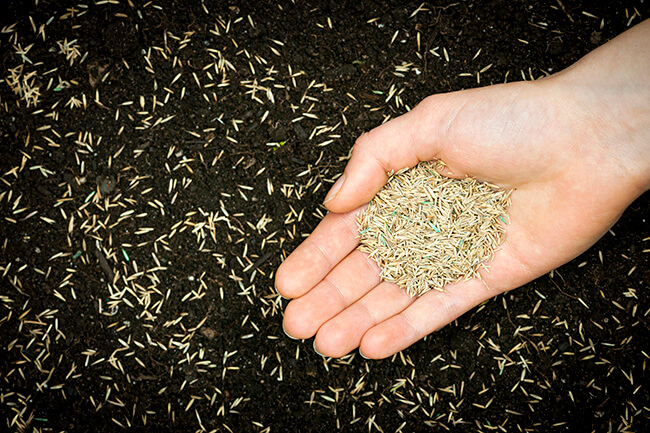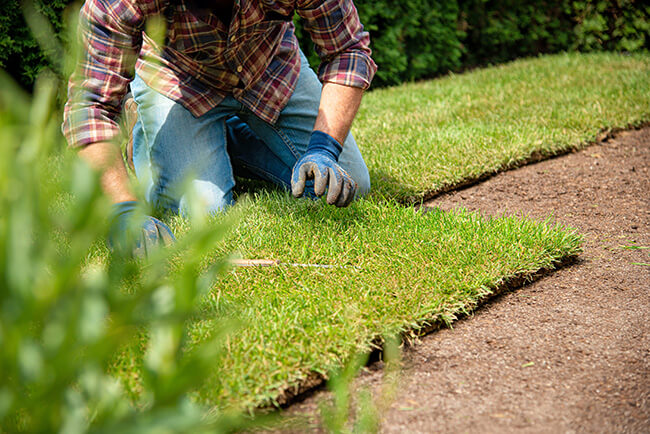Creating and maintaining a lush, green lawn is the goal of many homeowners. Because of the maintenance required to keep grass looking its best, some may opt to reduce total lawn area by adding hardscaping, softscaping, and xeriscaping. But, for those who love a verdant lawn, achieving it often comes down to a fundamental decision: seed or sod?
Both methods have their advantages and differences, and understanding them can help you make the best choice for your lawn. In this post, we’ll explore the pros and cons of seeding and sodding, as well as discuss the most suitable grass varieties for our region’s hardiness zones (5/6).
Seed or Sod – The Benefits of Grass Seed
 Seeding involves planting grass seed directly into the soil and allowing it to grow and establish over time. Here are some advantages of seeding:
Seeding involves planting grass seed directly into the soil and allowing it to grow and establish over time. Here are some advantages of seeding:
Cost-Effectiveness
Seeding is generally more budget-friendly than sodding, making it an attractive option for those looking to save money.
Variety
Seeding allows for a wider selection of grass varieties, including blends tailored to specific soil types, sunlight levels, and climate conditions.
Adaptability
Seeded lawns tend to develop deeper root systems, which can make them more resilient to drought and environmental stress over time.
However, seeding also has its drawbacks. It typically takes longer for seeded lawns to establish, requiring regular watering and maintenance during the germination period. Additionally, there’s a risk of erosion or soil disturbance before the grass becomes fully established.
Seed or Sod – The Benefits of Sod
 Sodding involves laying down pre-grown grass turf, complete with roots and soil, onto prepared soil. Here are some advantages of sodding:
Sodding involves laying down pre-grown grass turf, complete with roots and soil, onto prepared soil. Here are some advantages of sodding:
Instant Results
Sodding provides an instant lawn, with immediate coverage and a mature appearance. This makes it a popular choice for homeowners who want immediate results or have limited time for lawn care.
Erosion Control
Sodding helps prevent soil erosion, making it an excellent choice for sloped or vulnerable areas of the landscape.
Weed Suppression
Sodding can help suppress weed growth, as the dense turf outcompetes many weed species.
However, sodding is generally more expensive than seeding, and the selection of grass varieties may be limited compared to seeding options. Additionally, improper installation or care can lead to issues such as uneven settling or root detachment.
Grass Varieties for Hardiness Zones 5 and 6
In hardiness zones 5 and 6, which encompass regions with cold winters and moderate summers, several grass varieties thrive. For seeding, popular options include:
Kentucky Bluegrass
Known for its fine texture and deep blue-green colour, Kentucky bluegrass is well-suited to cooler climates and is often included in seed blends for its durability and attractive appearance.
Perennial Ryegrass
Perennial ryegrass is quick to establish and offers excellent wear tolerance, making it suitable for high-traffic areas.
Fine Fescue
Fine fescue varieties, such as creeping red fescue or Chewings fescue, are shade-tolerant and low-maintenance options for areas with limited sunlight.
For sodding, blends of Kentucky bluegrass and fine fescue are commonly used due to their adaptability and resilience.
Both seeding and sodding offer distinct advantages for establishing a healthy lawn. Seeding is cost-effective and allows for a wider range of grass varieties, while sodding provides instant results and helps prevent soil erosion. Ultimately, the best choice depends on factors such as budget, time constraints, and personal preferences. By selecting the right method and grass varieties for your specific needs, you can enjoy a vibrant, beautiful lawn for years to come.

